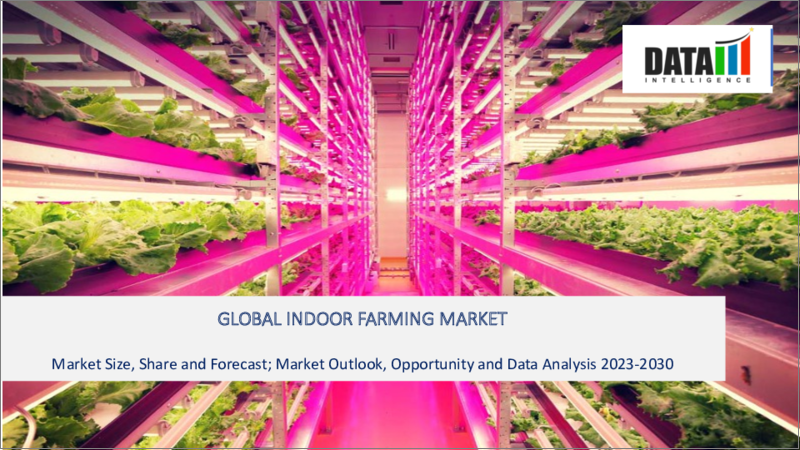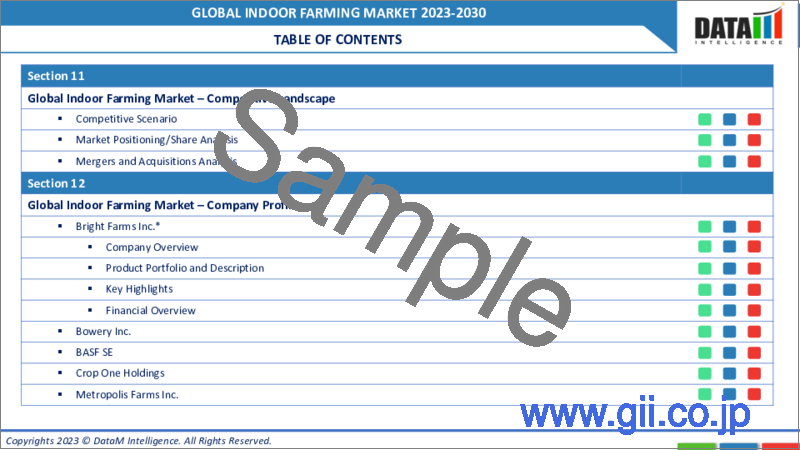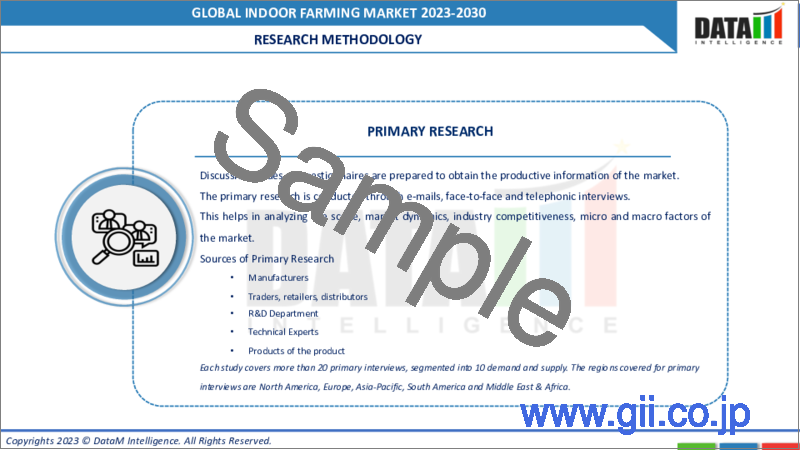|
|
市場調査レポート
商品コード
1304469
屋内農業の世界市場-2023年~2030年Global Indoor Farming Market - 2023-2030 |
||||||
|
● お客様のご希望に応じて、既存データの加工や未掲載情報(例:国別セグメント)の追加などの対応が可能です。 詳細はお問い合わせください。 |
|||||||
| 屋内農業の世界市場-2023年~2030年 |
|
出版日: 2023年07月07日
発行: DataM Intelligence
ページ情報: 英文 190 Pages
納期: 約2営業日
|
- 全表示
- 概要
- 目次
市場概要
世界の屋内農業市場は、2022年に342億米ドルに達し、2030年には561億米ドルに達すると予測され、予測期間2023-2030年のCAGRは6.4%で成長する見込みです。
屋内農業市場は、持続可能で地元産の農産物に対する需要の高まりにより、大きな成長を遂げています。この市場を牽引しているのは、限られた耕地、気候条件の変化、通年作物生産の必要性といった要因です。垂直農法、水耕栽培は、屋内農業市場で人気のある技術です。同市場では、植物の成長を最適化し生産性を向上させるためのAI、IoT、LED照明システムの利用など、技術の進歩が見られます。
食料安全保障も屋内農業の促進要因のひとつです。例えば、ニューヨークを拠点とする屋内農業企業Bowery Farmingは、制御された環境を活用することで、増加する世界人口に食料を供給するという課題に対処することを目指しています。従来の農法に比べ、1平方フィートあたり100倍の作物を生産できる一方、使用する水は95%少なく、農薬はゼロです。ニュージャージー州を拠点とするAeroFarms社は、垂直農法を利用し、土を使わずに葉物野菜やハーブを生産しています。
市場力学
消費者の需要が、新鮮で化学薬品不使用の農産物のための屋内農業市場を牽引します
新鮮で地元産の無農薬農産物を求める消費者需要の高まりにより、屋内農業は大きな成長を遂げています。制御環境農業、人工照明、気候制御、栄養管理、作物最適化技術により、農家は最適な条件で高品質の作物を栽培することでこの需要に応えることができます。人工照明によって年間を通じて生産が可能になり、気候制御によって温度と湿度が安定します。
栄養管理技術は植物の栄養を最適化し、より健康的で栄養価の高い作物をもたらします。作物の最適化戦略はスペース効率を最大化し、限られた面積でより高い収穫量を可能にします。屋内農業は、化学農薬使用に対する消費者の懸念に対応し、輸送に伴う二酸化炭素排出量を削減することで、持続可能で健康的な食の選択肢を提供します。
持続可能な食糧システムへのニーズに応えて成長する屋内農業市場
屋内農業市場の動向は、持続可能で弾力性のある食糧システムに対するニーズの高まりに後押しされています。制御環境農業、人工照明、気候制御、養分管理、作物最適化技術は、こうした目的を達成する上で重要な役割を果たします。屋内農業は、人工照明を利用することで、従来の農業に代わる持続可能な選択肢を提供するもので、場所を選ばず通年での作物生産を可能にします。
気候制御システムは最適な栽培条件を提供し、異常気象の影響を最小限に抑え、安定した収量を確保します。養分管理は肥料使用を最適化し、廃棄物や環境汚染を削減します。作物の最適化技術により、1平方フィートあたりの生産性を最大化し、限られたスペースを効率的に活用します。屋内農業は地元での食糧生産を促進し、輸送による排出を削減し、水資源を保全し、持続可能で強靭な食糧システムの構築に貢献します。
限られた拡張性が屋内農業の市場規模と市場シェアに課題をもたらす
屋内農業の重大な抑制要因の1つは、拡張性に限界があることであり、これが屋内農業市場全体のシェアと市場規模に課題をもたらしています。屋内農業は、管理された環境や年間を通した生産など数多くの利点を提供する一方で、初期費用や運営経費の高さがしばしば制約となります。高度な気候制御システム、人工照明、先進技術など、屋内農業に必要なインフラは、設置や維持に費用がかかります。
このため、特に小規模農家や資金力の乏しい地域にとっては、屋内農園の拡張性に限界があります。その結果、屋内農業の市場規模は、伝統的な農法に比べて相対的に小さいままです。さらに、屋内農業に必要な資本投資が多いため、市場シェアが集中し、資金力のある大企業が業界を支配し、中小企業の参入や成長が妨げられる可能性があります。
COVID-19影響分析
COVID-19分析には、COVID前シナリオ、COVIDシナリオ、COVID後シナリオに加え、価格力学(COVID前シナリオと比較したパンデミック中およびパンデミック後の価格変動を含む)、需給スペクトラム(取引制限、封鎖、およびその後の問題による需給の変化)、政府の取り組み(政府機関による市場、セクター、産業を活性化させる取り組み)、メーカーの戦略的取り組み(COVID問題を緩和するためにメーカーが行ったことをここで取り上げる)が含まれます。
目次
第1章 調査手法と調査範囲
第2章 市場の定義と概要
第3章 エグゼクティブサマリー
第4章 市場力学
- 市場への影響要因
- 促進要因
- 抑制要因
- 機会
- 影響分析
第5章 産業分析
- ポーターのファイブフォース分析
- サプライチェーン分析
- 価格分析
- 規制分析
第6章 COVID-19分析
第7章 栽培システム別
- 養液栽培
- 水耕栽培
- アクアポニックス
- 土壌ベース
- ハイブリッド
第8章 施設タイプ別
- ガラスまたはポリ温室
- 屋内垂直農場
- コンテナ農場
- 屋内DWCシステム
- その他
第9章 作物タイプ別
- 果物・野菜
- ハーブとマイクログリーン
- 花卉
- その他
第10章 技術別
- ハードウェア
- ソフトウェア
- 統合システム
第11章 地域別
- 北米
- 米国
- カナダ
- メキシコ
- 欧州
- ドイツ
- 英国
- フランス
- イタリア
- スペイン
- その他欧州
- 南米
- ブラジル
- アルゼンチン
- その他南米
- アジア太平洋
- 中国
- インド
- 日本
- オーストラリア
- その他アジア太平洋地域
- 中東・アフリカ
第12章 競合情勢
- 競合シナリオ
- 市況/シェア分析
- M&A分析
第13章 企業プロファイル
- AeroFarms
- 会社概要
- 製品ポートフォリオと説明
- 財務概要
- 主な発展
- Bright Farms Inc.
- Bowery Inc.
- FreshBox Farms
- Metropolis Farms Inc.
- Garden Fresh Farms
- Village Farms International Inc.
- Green Sense Farms LLC
- Sky Greens
- Argus Control System Limited.
第14章 付録
Market Overview
The Global Indoor Farming Market reached US$ 34.2 billion in 2022 and is expected to reach US$ 56.1 billion by 2030 and is expected to grow with a CAGR of 6.4% during the forecast period 2023-2030.
The indoor farming market is experiencing significant growth due to increasing demand for sustainable and locally grown produce. The market is driven by factors such as limited arable land, changing climatic conditions, and the need for year-round crop production. Vertical farming, hydroponics, and aquaponics are popular techniques within the indoor farming market. The market is witnessing advancements in technology, including the use of AI, IoT, and LED lighting systems to optimize plant growth and improve productivity.
Food security is another driver for indoor farming. For instance, Bowery Farming, an indoor farming company based in New York, aims to address the challenge of feeding a growing global population by utilizing controlled environments. They are able to produce 100 times more crops per square foot compared to traditional farming methods while using 95% less water and zero pesticides. AeroFarms, a company based in New Jersey, utilizes vertical farming to produce leafy greens and herbs without soil, using up to 95% less water compared to traditional farming methods.
Market Dynamics
Consumer Demand Drives Indoor Farming Market for Fresh and Chemical-Free Produce
Indoor farming is experiencing significant growth due to increasing consumer demand for fresh, locally sourced, and pesticide-free produce. Controlled environment agriculture, artificial lighting, climate control, nutrient management, and crop optimization techniques enable farmers to meet this demand by cultivating high-quality crops in optimal conditions. Artificial lighting allows for year-round production, while climate control ensures stable temperature and humidity levels.
Nutrient management techniques optimize plant nutrition, resulting in healthier and more nutritious crops. Crop optimization strategies maximize space efficiency, enabling higher crop yields in limited areas. Indoor farming addresses consumer concerns about chemical pesticide use and reduces the carbon footprint associated with transportation, providing sustainable and healthier food options.
Indoor Farming Market Grows in Response to Need for Sustainable Food Systems
The indoor farming market trend is driven by the increasing need for sustainable and resilient food systems. Controlled environment agriculture, artificial lighting, climate control, nutrient management, and crop optimization techniques play a crucial role in achieving these objectives. Indoor farming offers a sustainable alternative to traditional agriculture by utilizing artificial lighting, which allows for year-round crop production in any location.
Climate control systems provide optimal growing conditions, minimizing the impact of extreme weather events and ensuring consistent yields. Nutrient management optimizes fertilizer use, reducing waste and environmental pollution. Crop optimization techniques maximize productivity per square foot, making efficient use of limited space. Indoor farming promotes local food production, reduces transportation emissions, conserves water resources, and contributes to building sustainable and resilient food systems.
Limited Scalability Poses Challenges for Indoor Farming Market Size and Market Share
One significant restraint of indoor farming is the limited scalability, which poses challenges for the overall indoor farming market share and size of indoor farming market. While indoor farming offers numerous advantages such as controlled environments and year-round production, it is often constrained by high upfront costs and operational expenses. The infrastructure required for indoor farming, including sophisticated climate control systems, artificial lighting, and advanced technology, can be expensive to set up and maintain.
This limits the scalability of indoor farms, especially for small-scale farmers or regions with limited financial resources. As a result, the indoor farming market size remains relatively smaller compared to traditional farming methods. Moreover, the high capital investment required for indoor farming can lead to a concentrated market share, with larger companies dominating the industry due to their financial capabilities, hindering the entry and growth of smaller players.
COVID-19 Impact Analysis
The COVID-19 Analysis includes Pre-COVID Scenario, COVID Scenario, and Post-COVID Scenario along with Pricing Dynamics (Including pricing change during and post-pandemic comparing it to pre-COVID scenarios), Demand-Supply Spectrum (Shift in demand and supply owing to trading restrictions, lockdown, and subsequent issues), Government Initiatives (Initiatives to revive market, sector or Industry by Government Bodies) and Manufacturers Strategic Initiatives (What manufacturers did to mitigate the COVID issues will be covered here).
Segment Analysis
The global Indoor farming market has been segmented by the growing system, facility type, crop type, technology, and region.
Revolutionizing Indoor Farming with Sustainable Aquaponics
The global indoor farming market has been segmented by growing systems into aeroponics, hydroponics, aquaponics, soil-based, and hybrid.
Aquaponics, the combination of aquaculture and hydroponics, is a sustainable growing system within the global indoor farming market. It offers significant advantages, including approximately 90% less water usage compared to traditional farming methods. Aquaponics has the potential to yield up to four times more crops per unit of area, resulting in higher productivity. This innovative approach is gaining traction worldwide, driven by the increasing demand for organic and locally-grown produce.
The aquaponics segment is projected to experience substantial growth, with an estimated annual growth rate of around 14.2%. This growth is attributed to the rising awareness of sustainable food systems and the need for resource-efficient agriculture. Aquaponics presents a promising solution for integrated and environmentally friendly food production in indoor farming.
Geographical Analysis
Asia Pacific Indoor Farming Market Thrives on Growing Demand for Sustainable Produce
By region, the global indoor farming market is segmented into North America, South America, Europe, Asia-Pacific, Middle-east, and Africa.
The Asia Pacific indoor farming market is fastest growing region, driven by the increasing demand for sustainable and locally sourced produce. With limited arable land and a rapidly urbanizing population, the region is turning to indoor farming as a viable solution. The market growth is driven by countries like China, Japan, and South Korea. Indoor farming offers several advantages in the region.
The adoption of advanced technologies like vertical farming, hydroponics, and LED lighting is further propelling market growth. Government initiatives and investments are also promoting the expansion of the indoor farming sector. The Asia Pacific indoor farming market is flourishing due to the rising demand for sustainable produce. The adoption of advanced technologies and government support are driving the growth, enabling the region to achieve a more secure and environmentally friendly food system.
Competitive Landscape
The major global players in the market include: AeroFarms, Bright Farms Inc., Bowery Inc., FreshBox Farms, Metropolis Farms Inc., Garden Fresh Farms, Village Farms International Inc. Green Sense Farms LLC, Sky Greens, and Argus Control System Limited.
Why Purchase the Report?
- To visualize the global indoor farming market segmentation based on growing system, facility type, crop type, technology, and region, as well as understand key commercial assets and players.
- Identify commercial opportunities in the market by analyzing trends and co-development.
- Excel data sheet with numerous data points of indoor farming market-level with all segments.
- The PDF report consists of a cogently put-together market analysis after exhaustive qualitative interviews and an in-depth market study.
- Product mapping is available as Excel consists of key products of all the major market players.
The global Indoor Farming market report would provide approximately 61 tables, 62 figures, and 190 Pages.
Target Audience 2023
- Manufacturers/ Buyers
- Industry Investors/Investment Bankers
- Research Professionals
- Emerging Companies
Table of Contents
1. Methodology and Scope
- 1.1. Research Methodology
- 1.2. Research Objective and Scope of the Report
2. Market Definition and Overview
3. Executive Summary
- 3.1. Market Snippet, by Growing System
- 3.2. Market Snippet, by Facility Type
- 3.3. Market Snippet, by Crop Type
- 3.4. Market Snippet, by Technology
- 3.5. Market Snippet, by Region
4. Market Dynamics
- 4.1. Market Impacting Factors
- 4.1.1. Drivers
- 4.1.2. Restraints
- 4.1.3. Opportunity
- 4.1.4. Impact Analysis
5. Industry Analysis
- 5.1. Porter's Five Force Analysis
- 5.2. Supply Chain Analysis
- 5.3. Pricing Analysis
- 5.4. Regulatory Analysis
6. COVID-19 Analysis
- 6.1. Analysis of COVID-19 on the Market
- 6.1.1. Scenario Before COVID-19
- 6.1.2. Scenario During COVID-19
- 6.1.3. Scenario Post COVID-19
- 6.2. Pricing Dynamics Amid COVID-19
- 6.3. Demand-Supply Spectrum
- 6.4. Government Initiatives Related to the Market During the Pandemic
- 6.5. Manufacturer's Strategic Initiatives
- 6.6. Conclusion
7. By Growing System
- 7.1. Introduction
- 7.1.1. Market Size Analysis and Y-o-Y Growth Analysis (%), By Growing System
- 7.1.2. Market Attractiveness Index, By Growing System
- 7.2. Aeroponics *
- 7.2.1. Introduction
- 7.2.2. Market Size Analysis and Y-o-Y Growth Analysis (%)
- 7.3. Hydroponics
- 7.4. Aquaponics
- 7.5. Soil-based
- 7.6. Hybrid
8. By Facility Type
- 8.1. Introduction
- 8.1.1. Market Size Analysis and Y-o-Y Growth Analysis (%), By Facility Type
- 8.1.2. Market Attractiveness Index, By Facility Type
- 8.2. Glass or Poly Greenhouses *
- 8.2.1. Introduction
- 8.2.2. Market Size Analysis and Y-o-Y Growth Analysis (%)
- 8.3. Indoor Vertical Farms
- 8.4. Container Farms
- 8.5. Indoor Deep Water Culture Systems
- 8.6. Others
9. By Crop Type
- 9.1. Introduction
- 9.1.1. Market Size Analysis and Y-o-Y Growth Analysis (%), By Crop Type
- 9.1.2. Market Attractiveness Index, By Crop Type
- 9.2. Fruits & Vegetables*
- 9.2.1. Introduction
- 9.2.2. Market Size Analysis and Y-o-Y Growth Analysis (%)
- 9.3. Herbs and Microgreens
- 9.4. Flowers and Ornamentals
- 9.5. Others
10. By Technology
- 10.1. Introduction
- 10.1.1. Market Size Analysis and Y-o-Y Growth Analysis (%), By Technology
- 10.1.2. Market Attractiveness Index, By Technology
- 10.2. Hardware*
- 10.2.1. Introduction
- 10.2.2. Market Size Analysis and Y-o-Y Growth Analysis (%)
- 10.3. Software
- 10.4. Integrated Systems
11. By Region
- 11.1. Introduction
- 11.1.1. Market Size Analysis and Y-o-Y Growth Analysis (%), By Region
- 11.1.2. Market Attractiveness Index, By Region
- 11.2. North America*
- 11.2.1. Introduction
- 11.2.2. Key Region-Specific Dynamics
- 11.2.3. Market Size Analysis and Y-o-Y Growth Analysis (%), By Growing System
- 11.2.4. Market Size Analysis and Y-o-Y Growth Analysis (%), By Facility Type
- 11.2.5. Market Size Analysis and Y-o-Y Growth Analysis (%), By Crop Type
- 11.2.6. Market Size Analysis and Y-o-Y Growth Analysis (%), By Technology
- 11.2.7. Market Size Analysis and Y-o-Y Growth Analysis (%), By Country
- 11.2.7.1. The U.S.
- 11.2.7.2. Canada
- 11.2.7.3. Mexico
- 11.3. Europe
- 11.3.1. Introduction
- 11.3.2. Key Region-Specific Dynamics
- 11.3.3. Market Size Analysis and Y-o-Y Growth Analysis (%), By Growing System
- 11.3.4. Market Size Analysis and Y-o-Y Growth Analysis (%), By Facility Type
- 11.3.5. Market Size Analysis and Y-o-Y Growth Analysis (%), By Crop Type
- 11.3.6. Market Size Analysis and Y-o-Y Growth Analysis (%), By Technology
- 11.3.7. Market Size Analysis and Y-o-Y Growth Analysis (%), By Country
- 11.3.7.1. Germany
- 11.3.7.2. The U.K.
- 11.3.7.3. France
- 11.3.7.4. Italy
- 11.3.7.5. Spain
- 11.3.7.6. Rest of Europe
- 11.4. South America
- 11.4.1. Introduction
- 11.4.2. Key Region-Specific Dynamics
- 11.4.3. Market Size Analysis and Y-o-Y Growth Analysis (%), By Growing System
- 11.4.4. Market Size Analysis and Y-o-Y Growth Analysis (%), By Facility Type
- 11.4.5. Market Size Analysis and Y-o-Y Growth Analysis (%), By Crop Type
- 11.4.6. Market Size Analysis and Y-o-Y Growth Analysis (%), By Technology
- 11.4.7. Market Size Analysis and Y-o-Y Growth Analysis (%), By Country
- 11.4.7.1. Brazil
- 11.4.7.2. Argentina
- 11.4.7.3. Rest of South America
- 11.5. Asia-Pacific
- 11.5.1. Introduction
- 11.5.2. Key Region-Specific Dynamics
- 11.5.3. Market Size Analysis and Y-o-Y Growth Analysis (%), By Growing System
- 11.5.4. Market Size Analysis and Y-o-Y Growth Analysis (%), By Facility Type
- 11.5.5. Market Size Analysis and Y-o-Y Growth Analysis (%), By Crop Type
- 11.5.6. Market Size Analysis and Y-o-Y Growth Analysis (%), By Technology
- 11.5.7. Market Size Analysis and Y-o-Y Growth Analysis (%), By Country
- 11.5.7.1. China
- 11.5.7.2. India
- 11.5.7.3. Japan
- 11.5.7.4. Australia
- 11.5.7.5. Rest of Asia-Pacific
- 11.6. Middle East and Africa
- 11.6.1. Introduction
- 11.6.2. Key Region-Specific Dynamics
- 11.6.3. Market Size Analysis and Y-o-Y Growth Analysis (%), By Growing System
- 11.6.4. Market Size Analysis and Y-o-Y Growth Analysis (%), By Facility Type
- 11.6.5. Market Size Analysis and Y-o-Y Growth Analysis (%), By Crop Type
- 11.6.6. Market Size Analysis and Y-o-Y Growth Analysis (%), By Technology
12. Competitive Landscape
- 12.1. Competitive Scenario
- 12.2. Market Positioning/Share Analysis
- 12.3. Mergers and Acquisitions Analysis
13. Company Profiles
- 13.1. AeroFarms
- 13.1.1. Company Overview
- 13.1.2. Product Portfolio and Description
- 13.1.3. Financial Overview
- 13.1.4. Key Developments
- 13.2. Bright Farms Inc.
- 13.3. Bowery Inc.
- 13.4. FreshBox Farms
- 13.5. Metropolis Farms Inc.
- 13.6. Garden Fresh Farms
- 13.7. Village Farms International Inc.
- 13.8. Green Sense Farms LLC
- 13.9. Sky Greens
- 13.10. Argus Control System Limited.
LIST NOT EXHAUSTIVE
14. Appendix
- 14.1. About Us and Services
- 14.2. Contact Us




